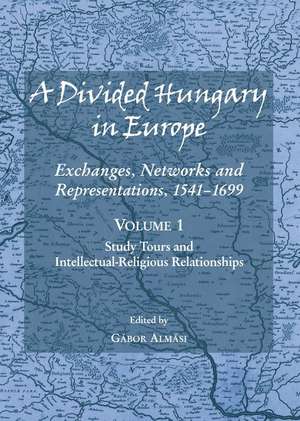A Divided Hungary in Europe: Exchanges, Networks and Representations, 1541-1699; Volumes 1-3
Editat de Gabor Almasi, Szymon Brzezinski, Ildiko Hornen Limba Engleză Hardback – 31 ian 2015
Preț: 545.27 lei
Preț vechi: 673.17 lei
-19% Nou
Puncte Express: 818
Preț estimativ în valută:
104.34€ • 113.69$ • 87.92£
104.34€ • 113.69$ • 87.92£
Carte indisponibilă temporar
Doresc să fiu notificat când acest titlu va fi disponibil:
Se trimite...
Preluare comenzi: 021 569.72.76
Specificații
ISBN-13: 9781443871280
ISBN-10: 1443871281
Pagini: 738
Dimensiuni: 147 x 206 x 25 mm
Greutate: 0.54 kg
Editura: Cambridge Scholars Publishing
Locul publicării:Newcastle upon Tyne, United Kingdom
ISBN-10: 1443871281
Pagini: 738
Dimensiuni: 147 x 206 x 25 mm
Greutate: 0.54 kg
Editura: Cambridge Scholars Publishing
Locul publicării:Newcastle upon Tyne, United Kingdom
Notă biografică
The editors of the volumes - Gabor Almasi, Szymon Brzezinski, Ildiko Horn, Kees Teszelszky and Aron Zarnoczki - are based at Hungarian, Polish and Dutch institutions of historical research. Their collaboration is the result of a joint research programme generously financed by the Hungarian Scientific Research Fund. Gabor Almasi is a Research Fellow at the Eotvos Lorand University of Budapest. He graduated from the Eotvos Lorand University and University College London, and obtained his PhD at the Central European University in Budapest. His publications include The Uses of Humanism: Andreas Dudith (1533-1589), Johannes Sambucus (1531-1584), and the East Central European Republic of Letters (Leiden 2009). Szymon Brzezinski is a PhD student at the Faculty of History, University of Warsaw, and Junior Research Fellow at the Department of Medieval and Early Modern History of Hungary, Eotvos Lorand University, Budapest. His research concentrates on the history of Polish-Hungarian relations, with his PhD project focusing on Polish-Transylvanian relations in the years 1539-1571. He is the author of the book Tanulmanyok a 16.-17. szazadi lengyel-erdelyi-magyar kapcsolattortenetrol [Studies of the History of Relationships between Poland, Transylvania and Hungary in the Sixteenth and Seventeenth Centuries] (2014). Ildiko Horn is a Lecturer and Head of the Department of Medieval and Early Modern History of Hungary at the Eotvos Lorand University of Budapest, from where she also graduated and obtained her PhD. She studies the history of politics, culture and mentality in sixteenth- and seventeenth-century Hungary and Transylvania. Her publications include Hit es hatalom: az erdelyi unitarius nemesseg 16. szazadi tortenete [Faith and Power: The History of 16th-century Unitarian Nobility in Transylvania] (2009). Kees Teszelszky is a Research Fellow at the Eotvos Lorand University of Budapest and Temporary Lecturer at the University of Amsterdam. He graduated from Leiden and Amsterdam, and obtained his PhD in Groningen (2006). His publications include Az ismeretlen korona. Jelentesek, szimbolumok es nemzeti identitas [The Unknown Crown: Meanings, Symbols and National Identity] (2009). Aron Zarnoczki is a PhD student at the Department of Medieval and Early Modern History of Hungary at the Eotvos Lorand University of Budapest. His research interests include the history of Hungary's and Transylvania's early modern diplomatic relations, with special regard to England, and the history of the English embassy at Constantinople. He has been the author of several articles, the editor of four volumes, and has organised several conferences.
Descriere
Despite fragmentation, heterogeneity and the continuous pressure of the Ottoman Empire, early modern "divided Hungary" witnessed a surprising cultural flourishing in the sixteenth century, and maintained this common cultural identity in the seventeenth century. This could hardly have been possible without intense exchange with the rest of Europe. This three-volume series about early modern Hungary divided by Ottoman presence approaches themes of exchange of information and knowledge from two perspectives: namely, exchange through traditional channels provided by religious/educational institutions and the system of European study tours (Volume 1: Study Tours and Intellectual-Religious Relationships), and the less-regular channels and improvised networks of political diplomacy (Volume 2: Diplomacy, Information Flow and Cultural Exchange). A by-product of this exchange of information was the changing image of early modern Hungary and Transylvania, which is presented in the third, and in some aspects concluding, volume of essays (Volume 3: The Making and Uses of the Image of Hungary and Transylvania). Unlike earlier approaches to the same questions, these volumes draw an alternative map of early modern Hungary. On this map, the centre-periphery conceptions of European early modern culture are replaced by new narratives written from the perspective of historical actors, and the dominance of Western-Hungarian relationships is kept in balance due to the significance of Hungary's direct neighbours, most importantly the Ottoman Empire.
